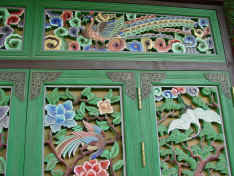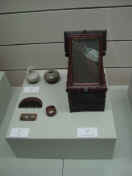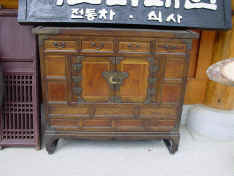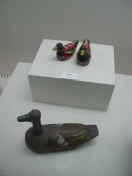
Introduction
to Korean Crafts
Native crafts are one of the most prominent features of
traditional Korean culture.
The study of Korean craftwork sheds much light on the nation's
cultural heritage. In this sense, "crafts" signify much more than
lacquered boxes or pottery bowls, for craftwork is closely associated with the
character of a people and thus reflects the dreams and aspirations of both
producers and consumers. In Korea, there is a well-developed crafts tradition.
Indeed, some foreign admirers of Korea, including Germany's Eckardt and Japan's
Yanagi Muneyoshi, have went so far as to describe Korea as the " land of
crafts."
Looking at crafts in order to understand the Korean artistic
sensibilities these foreign scholars concluded that the distinguishing feature
of the Korean aesthetic was to be found in its "natural beauty." This
can be attributed to the general Korean character which has traditionally felt a
close affinity to nature and thus prized natural beauty which was, as far as
possible, devoid of human contrivance.
Korean crafts can be broadly classed according to medium as:
metal crafts, wood crafts, ceramics, glass, dyed and woven goods and other
miscellaneous craftwork. Since structurally weak materials such as cloth,
leather and paper deteriorate rapidly, there are few old examples remaining,
except for lacquerware, and wood crafts. Thus, it must be kept in mind that the
modern research's focus on metal crafts and pottery has no bearing on the
comparative importance or function of these particular crafts in the past.
Korean Metalwork
Believed to have developed around the
beginning of the Bronze Age from 1000 B.C.-700 B.C., metalwork, along with
pottery and woodwork, occupies a central role in the history of Korean crafts.
Spiritual and political roles were not separate at this time; hence, metalwork
was employed to make knives, spears and other weapons as well as implements used
in religious ritual. Typical ritual implements of the time include bronze
mirrors with geometric designs, assorted bells and bronze vessels with
agricultural motifs. On the back of the latter, there were depictions of birds
sitting on tree branches; hence, these are thought to have been used at the sodo-sacred
sites where rituals were held. The sophisticated forging techniques used to
create geometric-design mirrors at this time have been a riddle for scholars.
Judging from the mirrors' fine designs, metalworkers from this era were already
using the bees-wax smelting techniques that are still in use today.
During the Iron Age, metalwork was primarily
used to create weapons and farming implements. Strong yet easy to shape, iron
facilitated outstanding developments in tools used to make both everyday
utensils and decorative articles. A good example is the development of the saw,
which made the creation of wooden crafts possible for the first time.
The colorful, precious-metal articles
discovered in ancient tombs indicates that Korean metalcraft had already
attained a high level of development by sometime around the fourth or fifth
century. Decorated using buffeting, serration and inlay techniques, metal crafts
from this period were placed in tombs, which were thought of as the future
domicile of the deceased person's spirit. Elaborate adornment such as crowns,
earrings, necklaces, rings, belts and shoes were fashioned from gold, silver and
other precious metals. In addition to their role as burial objects, these served
to indicate a person's status as part of the ruling class.
Back to Top
Metalcraft had initially been primarily
employing precious metals, but during the Three Kingdoms and the subsequent
Unified Shilla period, metal craftsman gradually began to use more practical
materials such as copper and iron. As this trend became more widespread during
the Koryo period, general craftwork and even Buddhist art was produced using
copper. Examples include large bells, incense burners, metal drums,
"cloud-plate" gongs and kundika (elixir bottles). Although gold and
silver were not used as basic materials at this time, the art of gold overlay on
copper became advanced. Other notable developments of this period include
refinements in sculpturing techniques and the use of metallic threads to create
detailed metalwork designs. Since silver threads were primarily used, the latter
is often called unipsa (silver damascening). Along with celadon inlay and
mother-of-pearl inlay, it was a decorative technique that became particularly
advanced during the Koryo period. It reflects the grandeur of Koryo period
religion as well as the elaborate tastes of Koryo aristocrats.
With the advent of the Choson period, the
tendency towards intricate decoration in metal craftwork disappeared, while
brassware, which had previously been valued more than even white-glaze
porcelain, became an everyday household item. In accordance with ancient
traditions, brassware continued to be the material used exclusively for ritual
vessels. As brass implements became widely available, larger households used
porcelain during the summer and brassware, which was better at retaining heat,
during the winter.
The Choson period, with its practical outlook,
signaled a general decline in metalwork technique. During this time, metalware,
which had previously been used exclusively by the privileged class, became
widely available to the common people.
With the development of copper and tin alloy,
high-quality bowls and musical instruments were produced in large quantities.

Korean Pottery
From early times, pottery has served both a
practical function as a source of everyday utensils as well as an artistic
medium of expression. The development of pottery techniques played an important
role in the general development of Korean craftwork. During the prehistoric
period, comb-pattern pottery, plain pottery, red-glaze and black-glaze
earthenware as well as Kimhae-style pottery were produced. Looking at the
gradual development of these pottery forms, one can sense the aspirations of
Korea's prehistoric inhabitants as they struggled to improve their living
conditions.
During the Three Kingdoms period, each kingdom
developed a unique style based on Kimhae pottery. Typical examples include
Koguryo pottery, which closely resemble the Kimhae style it was derived from,
Paekche's gray tripod vessels and Shilla's stemmed cups (kobae) and
vessel stands. Most of the extant pieces of ancient pottery and metalwork have
been burial objects found in ancient tombs. Among these relics, one finds
exquisitely crafted Shilla and Kaya pottery depicting ducks, houses, boats and
figures on horses.
As craft traditions of the former Three
Kingdoms developed during the Unified Shilla period, pottery forms and patterns
began to change. The long-necked dropper and box with lid appeared at this time.
In particular, developments in kiln structure allowed craftsmen to accumulate
experience using natural-looking, green glazes. This period of experimentation
served as an important stepping stone in the development of Koryo celadon.
Back to Top
During the Koryo period, hard earthenware
continued to be produced; yet the most representative pottery of the era is
celadon. Korean celadon can be divided into two types: West Coast pottery was
produced using the oxidation techniques of Northern China and Kangjin/Puan
pottery was produced using the reduced firing techniques of South China. Of
these two types, the latter was more influential. Korean celadon uses a delicate
green feldspathic glaze with around a three percent iron content. This lovely
pottery soon became popular both in Korea as well as internationally as one of
the most representative genres of Korean art. For example, Xu Jing (Kor. So
Kung), a twelfth-century Song envoy to Korea, highly praised the superiority of
Korean celadon in his detailed work Koryo togyong (Illustrated Account of
Koryo).
Scholarly opinions vary, but the first
production of Koryo celadon must have begun by the late-ninth or early-tenth
century at the latest. It reached its apex during the eleventh and twelfth
centuries. Around the twelfth century, potters turned their attention from the
exquisite shapes and fine jade color of pure celadon to white and black
porcelain featuring detailed inlay designs of cloud and crane motifs or
chrysanthemums. The superiority of Koryo celadon is widely recognized, but inlay
pottery also deserves credit for its creativity and formal beauty. Notably,
Korean potters experimented with red copper underglaze before their Chinese
counterparts.
During the late-Koryo period, oxidation firing
techniques became popular.
During this time, glazes also underwent change
while the formal tension of bowls was softened. Collectively, these changes led
to the development of Choson punch' ong ware.
During the Choson period, punch'iong
ware and white porcelain were the chief pottery styles. Punch'aong is
classified according to production technique as: kamhwa (punch'aong
ware with inlaid floral decorations), inhwa (punch'wong decorated
with stamped floral designs), pakchi (Graffito), chohwa (bird and
flower motif), ch'rorhwa (iron pigment) and paekt'o. Popular from
the early Choson period to the period directly preceding the Hideyoshi
invasions, paekt'o punch'hong used white slip designs which seemed to get
smaller as the style developed. Comparable with the simple surface effect in
minimalist art, these pieces agree well with modern artistic sensibilities. This
pottery thus served as a transitional form between inlaid celadon and white
porcelain (paekcha) and in spite of its rather common look, it was highly
prized even by the royal house.
White porcelain, on the other hand, was an
article of everyday use by all strata of society throughout the Choson period.
During this period, specially-designated kilns under the strict supervision of
the Saongwon (Bureau for Overseeing Ceramic Production) were able to ensure that
the quality of white porcelain was maintained at a fixed level. During this
time, red (iron) or blue pigments were also used to draw depictions of the
"four gentlemen" (plums, orchids, chrysanthemums and bamboo), dragons
and auspicious symbols on top of milky-white porcelain. Sometimes, these
pictures were painted by government artists. By the late-Choson period, the
consumer class for pottery had expanded to include the lower stratums of
society. As a result, pottery declined as it entered the modern era.

Korean Wood
Crafts
Since woodwork makes use of a natural,
production of articles from wood, it is relatively simple. For this reason, it
has been widely used in craftwork since ancient times. In Korea, the structure
of the elegant, single-story, wooden houses and the custom of sitting on heated
floors provided further impetus to the diverse and extensive utilization of
wooden handicrafts.
Various tree-felling tools such as axes and
saws indirectly attest to the existence of woodwork during the Bronze and Iron
Ages. Particular examples include the wooden artifacts dating from around the
first centuries B.C. or A.D. which were recently discovered along with a large
basket in Taho-ri Village in Ch'angwon.
The nature of Koguryo furniture can be
ascertained by looking at tomb murals from the period. Notably, the furniture
can be distinctly divided into two categories. Depictions from the P'yongyang
area show furniture influenced by Han China with many legs, while depictions of
furniture from the T'ung-kou region show tables and trays with horse-hoof style
legs. Since the Koguryo territory extended deeply into the Asian continent, the
paintings at T'ung-kou-a more central region-are thought to be more
representative of the basic Koguryo style.
The lacquered crown decorated with silver and
gold that was excavated from the Paekche King Muryong's tomb, other Shilla
artifacts and the existence of special government offices in charge of woodwork
indicates that woodwork was not only used as burial objects but also used for a
diverse range of everyday objects.
During the Koryo period, refined craftwork
enjoyed its heyday. Particularly suited to aristocratic tastes, mother-of-pearl
lacquerwork flourished at this time. Made by applying colorful abalone shell in
designs on lacquered wood, Koryo mother-of-pearl was used to make a diverse
range of objects including boxes for sutras or Buddhist rosaries. At one point,
a special government office, known as the Chonham Chosong Togam, was temporarily
created in order to make lacquerware for the Chinese royal house. This period
also saw the production of colored tortoise shell using the Taemo technique.
Stylistically, this is associated with the ox-horn decorations which became
popular during the Choson period.
The representative furniture of the Choson
period is of a practical yet appealing geometrical design. With a simple beauty,
the pieces of this period incorporate the natural patterns of the wood. Due to
the unique aesthetic sense evident in pieces from this period, Choson furniture
is highly prized both in Korea and overseas. Furniture styles from this period
were influenced by Confucianism which upheld a strict distinction between the
genders, valued humility and frugality and sought a scholarly and gentile
lifestyle. Furniture forms and styles of the period were largely determined by
social status and use, with specific types of furniture placed in the sarangbang
(reception room for male visitors) and other types used in the wife's areas
such as the kitchen and anbang (bedroom). Notably, the furniture of the sarangbang
was of a simple and natural construction reminiscent of the simplicity found
in Choson-era white porcelain.

Other
Korean Handicrafts
Other handicrafts, including glass, leather,
paper, stone and woven goods, also developed in Korea. The Kyongguk taejon,
a treatise on government written during the early Choson period, lists 129
different types of crafts.
Examples include glass crafts of the Three
Kingdoms and Unified Shilla period as well as hanji (Korean paper crafts)
which were popular even in China. Weaving was developed as a practical craft,
with the leftover pieces of cloth used to make ornate pouches. Appealing to
modern tastes, the latter have enjoyed great popularity in recent times.
Korea's Crafts
During the Occupation
In Korea, the process of modernization has
been particularly turbulent, and Korea's crafts have suffered even more than
other areas of society as a result. With the advent of modern manufacturing
machinery from the West, there was a great reduction in traditional Korean
handicrafts. This trend was exacerbated by a tendency to see traditional crafts
as a stumbling block to modernization. As Koreans suddenly lopped off their long
hair in favor of Western hairstyles, over ten traditional crafts became useless
almost overnight.
Within these dire circumstances, organizations
such as the Yi Wangjik Misulp'um Chejakso (Yi Wangjik's Art Production Center)
and the Choson Misul Chollamhoe deserve mention for their efforts towards
preserving and developing traditional crafts. Founded in 1908, the former sought
to address the collapse of traditional handicrafts centers as well as the
qualitative decline in handicraft products. It thus began production of
handicrafts in search of "the essence of traditional Choson
handicrafts." Known as the Hansong Misulp'um Chejakso when founded, it
operated as Yi Wangjik Misulp'um Chejakso from 1911 to 1922, and then as
Chusikhoesa Choson Misulp'um Chejakso until 1937 when it was abolished. As its
name changed, so did its management as well as the designs in the crafts that it
produced.
When operated as the Hansong Misulp'um
Chejakso, the factory consisted of a design center, a manufacturing center and
an office. Within the manufacturing center, there were departments dedicated to
metalwork, woodwork and woven goods according to the traditions of the Choson
royal house. During this time, the factory enjoyed a certain autonomy, but like
the Yi Wangjik Misulp'um Chejakso, it came under Japanese management. As a
result, its facilities were expanded and arranged into eleven departments
devoted to: mother-of-pearl crafts, woodcraft, inkstones, casting, forging,
jewelry, carving, wire-design metalwork, pottery, brass and weaving. However,
the craft designs were gradually altered around this time to better suit
Japanese artistic sensibilities. By 1922, the factory lost even its nominal
autonomy and became a private corporation. Mainly devoted to producing mementos
and trophies, the Japanese influence on its work became even more pronounced.
Back to Top
In opposition to the original goals of these
production centers, the Japanese managers encouraged the commercialism and the
distortions of traditional designs. On the other hand, these centers produced
figures such as Kim Chong-sop, Yi Hak-ung, Kim Chin-gap and Kim Pong-nyong, who
went on to become leaders in preserving and developing Korean craft traditions
after liberation.
The modernization process in Korea,
circumscribed by Japanese colonialism, had certain inherent limitations. Most
importantly, Korea was unable to develop an autonomous force capable of adopting
its craft traditions to the modern world. Korean handicrafts were unable to fit
in with the modern world in which design process took precedence over manual
skill.
During the Tenth Exhibition of Choson Art in
1932 a crafts department was established, giving traditional craftsmen a modern
venue where they could make their debut. However, the number of native Korean
artists at the exhibition was limited. Mother-of-pearl and woodwork accounted
for a full third of the pieces exhibited. This forms an interesting contrast
with the Misulp'um Chejakso where metalwork was the main product.
Of the pieces presented at the exhibition,
some strictly adhered to the tradition of Choson art while others introduced
elements from Western crafts. Other artists, influenced by the occupation,
incorporated Japanese elements into their art. At the same time, some
neoclassicist craftsman studied Koguryo murals and Nangnang lacquerware patterns
to create art resembling these ancient relics. This neoclassicist movement was
based on the discovery and excavation of ancient tombs along with the active
interest in ancient historical research. It received further impetus from the
era's nationalist ideology.
Modern
Korean Crafts
In the fifty years since liberation, Korean
crafts have experienced significant change as they passed over the threshold to
the modern world. In the 1950s, university crafts departments were established
amid the rubble of the Korean War. These new departments naturally took their
place within general arts departments which were organized around painting and
sculpture. Traditionally, Korean crafts had developed within a teacher/disciple
relationship, but as crafts entered universities, scholars of traditional crafts
began to provide systematic education that reflected the major trends of modern
craftmanship.
Needless to say, modern art studies from this
era were based on Western aesthetic values introduced via Japan and Japanese
artistic sensibilities. This alienation from traditional Korean artistic values
largely resulted from the misconception that "Western" was synonymous
with "modern."
Back to Top
1) With the introduction of industrial design
in the 1950s, handicrafts' social role was reduced. The era is characterized by
the creation of a national crafts department, the founding of various
organizations devoted to traditional crafts and an increase in popularity of
special regional goods. In particular, the struggle between leftist and rightist
political factions splintered the native crafts movement into over ten distinct
craft organizations.
Leading figures of the national exhibition,
initially known as the Kukchon and as the Sonjon during the Japanese occupation,
include woodwork craftsmen such as Kim Chin-gap, Kang Ch'ang-gyu and Chang
Ki-myong, stoneworkers such as Yi Sun-sok and potters such as Kim Chae-sok.
2) The 1960s saw the development of a number
of important galleries such as The Design Center, Taehan Min-guk Sanggong
Misuljon and Kungnip Hyondae Misulgwan. During this era, there were numerous
foreign exhibitions and international exchanges and thus the era is
characterized by the rapid expansion of Korean craft production. Each year,
there were about ten private and group exhibitions and around ten new craft
organizations were formed.
One of the most important developments during
this decade was the gradual reemergence of metalcraft and pottery from the
stagnation of the previous decade.
This renewed interest was stimulated by
increased information on Western crafts.
3) During the 1970s, there was a new interest
in all aspects of traditional Korean culture. Systematic efforts were made to
preserve and develop traditional crafts, many of which had previously been on
the verge of disappearing in the wake of modernization. In order to preserve
traditional knowledge, the government gave talented artisans official support,
designating them as "Important Intangible Cultural Treasures" or
"Human Culture Treasures." Around this time, the mother-of-pearl
artist Kim Pong-nyong and lacquerware artist Kang Ch'ang-gyu both established
galleries for traditional works.
Another important development during the 1970s
was the creation of private crafts exhibitions at galleries. This stemmed from
attempts to incorporate traditional crafts into the formative arts. Pottery was
a leading force behind this movement.
Influenced by American and Japanese pottery,
Korean potters began to experiment with non-functional pottery forms. This
purely formal emphasis had entered the mainstream by the late 1980s.
Back to Top
4) Since the 1980s, formalism has become a
leading influence on Korean craftwork.
Initially, there were a few textile and
pottery craftsmen experimenting with formal works, but by the late 1980s, the
trend has swept through every traditional genre. In addition to individual
artists, universities were influenced by this trend, leading to the development
of curriculums teaching the techniques and theory behind formal art. Yet, as
interest turned towards purely formal works, there was less interest in making
traditional crafts for practical, everyday use.
From the mid-1980s to around 1990, on the
other hand, various artists and groups began to take express an interest in a
revival of works more suitable for everyday life. In the mid-1980s, college
craft majors established small studios where they produced and supplied everyday
items appealing to a wide spectrum of society. In the 1990s, exhibitions began
to appear in which the theme was practical. This new trend had a significant
effect on artists preoccupied with solely formalistic works. In the 1980s this
movement was chiefly centered around young artists in training, but by the
1990s, the movement had matured, with many prominent artists joining its ranks.
As it comes to the late 1990s, the purely
formalistic movement seems to be faltering, while the movement towards practical
crafts seems to be gaining wide support from consumers and cultural circles.
|
